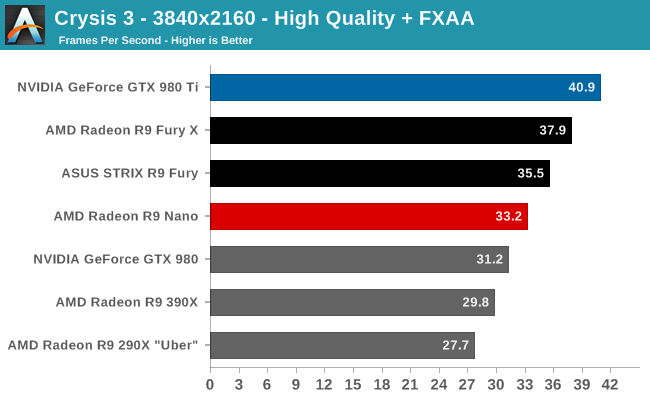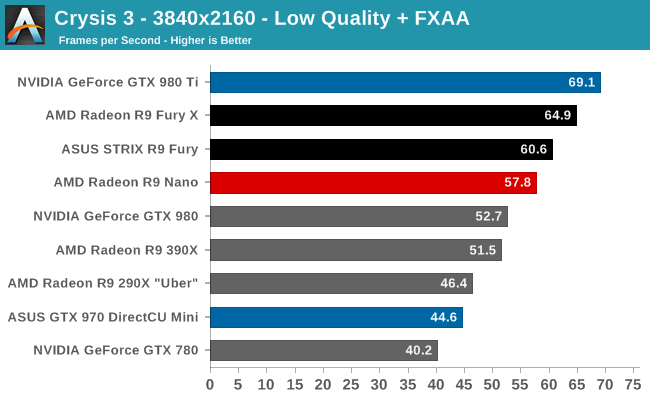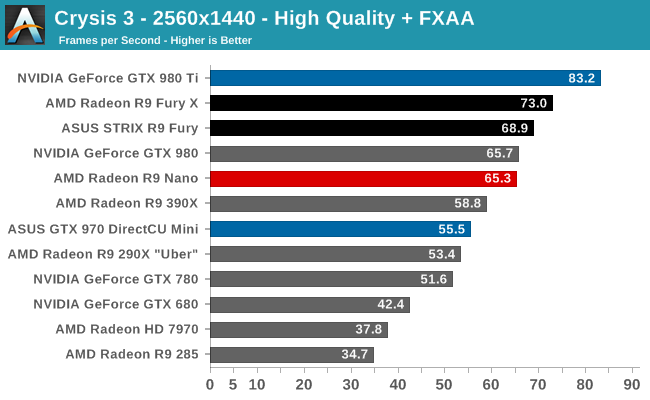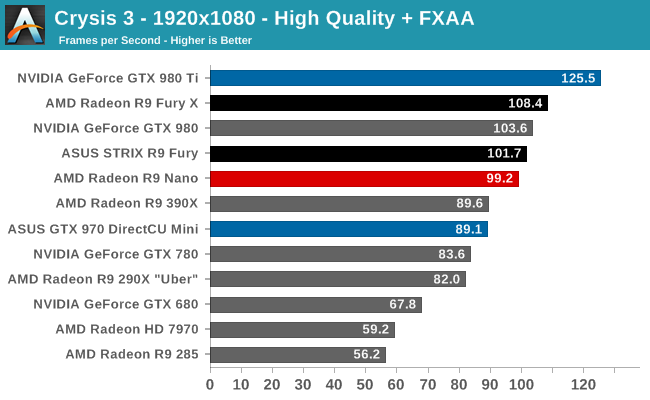The AMD Radeon R9 Nano Review: The Power of Size
by Ryan Smith on September 10, 2015 8:00 AM ESTCrysis 3
Still one of our most punishing benchmarks, Crysis 3 needs no introduction. With Crysis 3, Crytek has gone back to trying to kill computers and still holds the “most punishing shooter” title in our benchmark suite. Only in a handful of setups can we even run Crysis 3 at its highest (Very High) settings, and that’s still without AA. Crysis 1 was an excellent template for the kind of performance required to drive games for the next few years, and Crysis 3 looks to be much the same for 2015.




As with Battlefield 4, the R9 Nano solidly secures its place relative to the Fury lineup, delivering 90-95% of the performance of the R9 Fury X and R9 Fury respectively. This pushes the card’s performance below 60fps even at 3840x2160 low quality, but it’s more than enough for 2560x1440.
However once we do reach 2560, we find that the R9 Nano is now tied with the GTX 980 at just over 65fps. As we mentioned on the last page the GTX 980 is the biggest threat to the R9 Nano from an efficiency standpoint, and this is why. Limiting our scope to just mini cards however finds the R9 Nano comfortably ahead of the GTX 970 Mini.
Meanwhile Crysis 3 is a great example of why AMD is poking at themselves by comparing the R9 Nano to the GTX 290X. The card is little more than half the length of AMD’s former flagship and yet delivers 22% better performance while drawing much less power (more on that later). In doing so AMD is clearly picking a low point to make their gains look better, but at the same time it shows that yes, AMD can in fact improve over R9 290X on performance, power, and noise all at the same time.










284 Comments
View All Comments
Drumsticks - Thursday, September 10, 2015 - link
??? I never said I was going to buy the Nano. You just said exactly what my plan was, to buy a GPU when 16nm FF hits. I'm still chugging along with 1080p and a 7850, but I'll probably be grabbing QuadHD or 4K next year with a big GPU upgrade.That doesn't mean that looking at potential DX12 performance now won't give a hint of what's to come, though. AMD stands to gain a lot from dx12 from what we've seen.
mosu - Thursday, September 10, 2015 - link
With a 16nm FinFet you'll get Nvidia, a 14nm FinFET will come from Glo-Foundries, so you'll get something from AMD.extide - Thursday, September 10, 2015 - link
It's NOT a lack of ROP's guys, its a lack of geometry bhardware. Check out the pixel fill rate tests, that does NOT indicate a lack of ROP's. This car beats the 980 at high res, but not low res, thats NOT a ROP issue, that's either driver overheard and/or geometry issue.silverblue - Friday, September 11, 2015 - link
I wonder if AMD has ever responded to the issue of driver overhead. If not, they should. It's a massacre at lower resolutions and detail levels at times.jardows2 - Thursday, September 10, 2015 - link
I do not see any enthusiast buying this card for their own build. Where I do see this card selling is in boutique systems sold for a combination of style and performance. In a tiny system targeted for 1440 gaming, which I think should be the focus rather than 4k, this would do great!MrSpadge - Thursday, September 10, 2015 - link
That voltage-frequency curve looks horrible! From the average clocks speeds we know the card is mostly running between 800 and 900 MHz. Yet on that plot we see no power states defined between 0.93 V and 1.04 V. Yet that's where the card would need to operate between 750 and 850 MHz. Why is AMD limiting their power efficiency by providing too few power states? Or is it simply a matter of measuring the low voltages correctly?teiresias - Thursday, September 10, 2015 - link
What were the terms Anandtech agreed to with Roy Taylor in order to secure this Nano sample? I honestly can't take any review of this product seriously unless the editorials of each site come out with statements on what their agreements with AMD were concerning review content.Ryan Smith - Thursday, September 10, 2015 - link
"What were the terms Anandtech agreed to with Roy Taylor in order to secure this Nano sample?"For the record I didn't need to agree to any terms. Nor have I conversed with Roy in quite some time.
jtrdfw - Thursday, September 10, 2015 - link
Thats good.Wreckage - Thursday, September 10, 2015 - link
If they agreed to anything it would probably be covered under a "non disclosure agreement" so legally they would not be able to say anything. Such an agreement would come from AMD marketing, not from Roy directly. I assume there was some sort of reviewers guide they wanted people to follow. How strictly any site followed that guide or why certain sites were deemed "fair" by AMD will most likely remain speculation